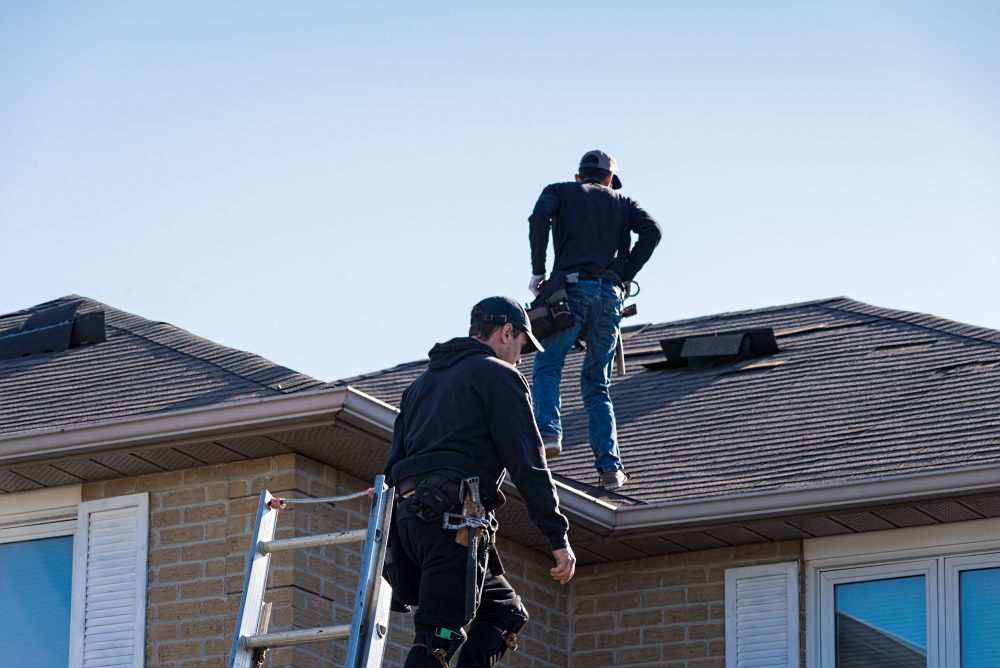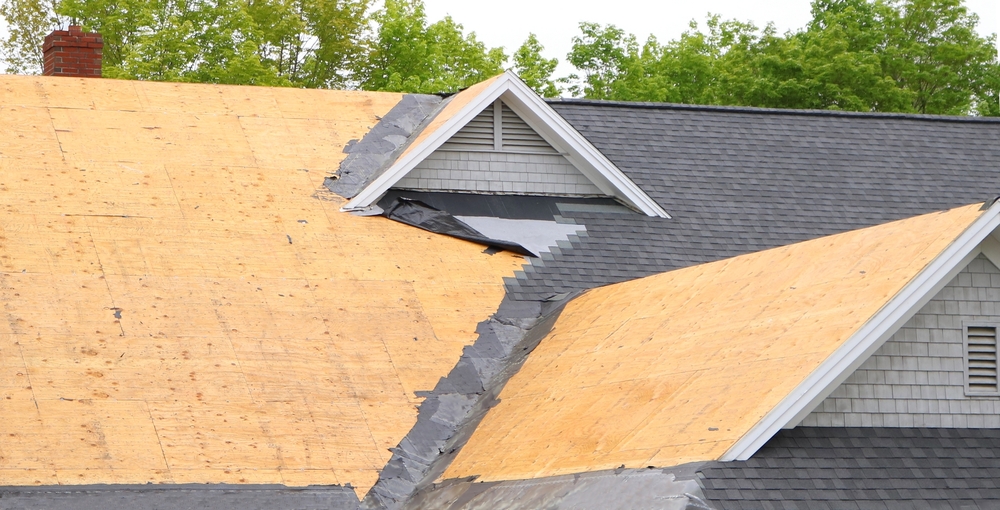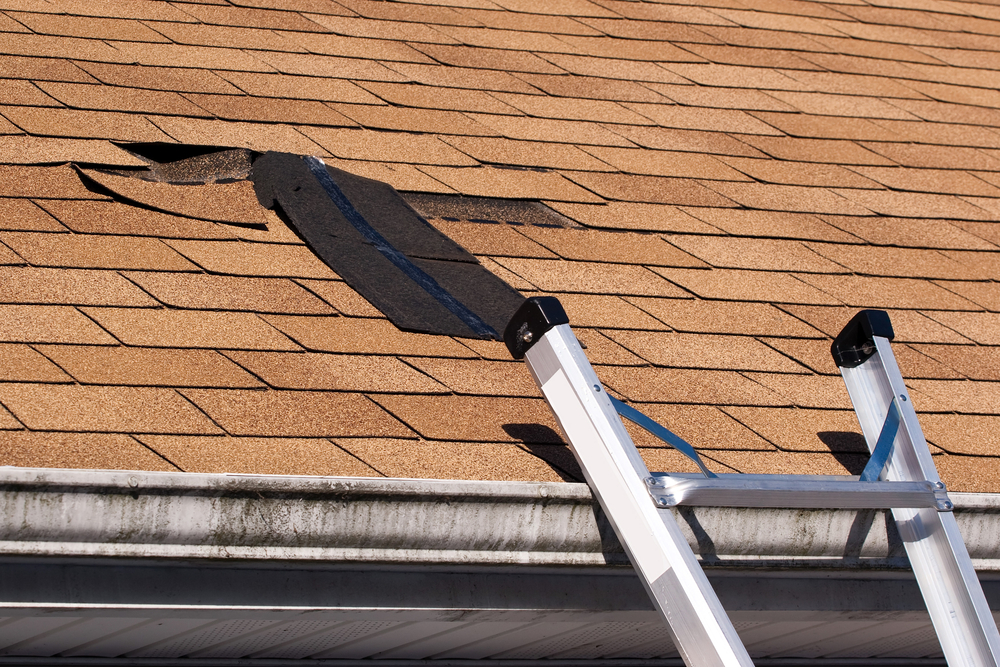
by siteadmin | Aug 9, 2019 | Roof Damage, Temporary Roof Repair
For many homeowners, DIY repairs offer a quick, inexpensive way to improve your house. There’s certainly plenty of housework that DIY can easily handle. However, for more important home repairs or maintenance, you may not be able to fix the problem yourself. Roof repairs fall into this category.
The safety and efficiency of DIY roof care depend on a number of factors, but fixing the roof yourself is generally not advised. Aside from immediate safety concerns, there is also the possibility that you might only worsen the problem. Consider a few key components before you start your DIY roof project.
Safety Concerns
Roof maintenance does require you to spend a fair amount of time on top of your house. Aside from the possibility of falling over the edge, the damage to your roof could be severe enough that putting additional weight on the roof is not safe. The roof itself could break. Not only does this add more costly repairs to your project, but you could also find yourself falling through a hole in your own roof. You open yourself up to potential risks with DIY roof maintenance.
Thorough Repair Work
Unfortunately, the average homeowner doesn’t always recognize the signs of subtle roof damage. Whether it’s from wear and tear or a particular weather disaster, your roof takes quite a beating with time. Not knowing what roof damage looks like means that you can easily overlook necessary repairs in your DIY project. Hire a professional to perform a thorough roof inspection to make sure you get the best repair possible.
Pro Tip: While it’s best to leave a thorough inspection to the experts, keep an eye on your roof. Check for water damage after heavy storms and call a repair service if anything seems wrong.
When is DIY Appropriate?
For a simple repair, taking care of the problem yourself will cost you less time and money. A few cases where DIY is appropriate include:
- Caulking leaks
- Replacing a couple of shingles
- Cleaning the gutters
- Removing leaves and other small debris
These small projects require little effort or precision to get exactly right, so the risks involved in performing these repairs yourself is minimal. However, don’t overestimate your abilities. If your roof is badly damaged or needs more extensive repairs, save yourself a headache and call a professional.
Extend the Life of Your Woodlands Roof with Professional Maintenance
Roof care may not be a major concern for you unless you’re dealing with severe leaks or damage. But if you regularly have your roof inspected by a professional and perform small DIY maintenance yourself, you can extend the life of your roof and by extension, the rest of your house. Keep your home in good shape with periodic inspections and repairs.
Ready to schedule your free roof inspection? Connect with us and start talking with our roofing experts!

by siteadmin | Aug 2, 2019 | Roof Inspection, Roof Repair, Roof Replacement
There’s no question that preventive maintenance work on your home can save you an immense amount of effort and money later on. It’s better to catch a problem when it can be easily handled than to let it worsen with time. However, your roof may be a different story. When is it appropriate to replace the entire thing, and when can you get by with just a few repairs?
Depending on the extent of damages, you may only need a cosmetic touch up or minor repair instead of a full roof replacement. However, choosing one solution too quickly does you no favors. Before you decide on the type of work your roof needs, it’s important to assess the damage and consult an expert.
Patching Over Minor Damage
Missing shingles can result in damage to the roof itself. Fortunately, homeowners may get lucky and only end up with a minor hole or weak spot in the roof. In this case, you may be tempted to think a quick patch will take care of the problem. This may seem like an easy fix, but you should always let an expert inspect the roof first. The damage may have spread further than it first appears. Additionally, adding patching an old roof in need of repairs with brand new roofing materials may just make the whole situation worse. Never assume a patch will fix the deeper issue.
Replacing Shingles or Tiles
If only a few shingles or tiles are missing, a quick replacement is probably all you need. Once again, however, the true answer depends on the rest of your roof. Does the damage extend into the structure itself? Are the other shingles on the roof buckled or peeling? Shingles are designed to last for decades, so if you notice the other shingles starting to fall apart, that’s a sign of serious damage below the surface.
Additionally, if you see granules from your asphalt shingles showing up on the ground or in your roof’s gutters, that indicates moderate to severe roof damage. Call a roof repair service immediately.
Pro Tip: Replacing only damaged shingles or tiles while ignoring the roof structure itself runs the risk of ignoring subtler problems. Always have the roof inspected too.
A Whole New Roof
Finally, there will be times when you can’t get away with mere repairs and have to settle for an entirely new roof. If your roof has recently suffered severe storm or water damage, the materials are deteriorating, or your home is simply old and in need of renovations, you’ll find yourself having a new roof installed. Your roofing contractor will help you determine the exact extent of necessary work.
Determining the Best Course of Action
Your roof is your home’s first line of defense against wind, rain, hail, and more. Even minor damages can be catastrophic if left untreated. Before you decide on whether to replace or repair your roof, make sure to consult with an expert on the best decision to prevent your house from sustaining further damage.
Connect with us to schedule your free roof inspection today!

by siteadmin | Jul 26, 2019 | Roof Damage, Roof Leaks, Temporary Roof Repair
From time to time, you’ll find yourself dealing with a leaky roof and no easy solution. Maybe it’s a holiday weekend and your roof repair service can’t come for a few days, or maybe they’re waiting on supplies themselves. Whatever the cause, the situation likely calls for a temporary roof repair while you wait for a permanent solution.
Don’t let potential water damage to your home get any worse while you wait on permanent roof repairs. With careful efforts, you can make a temporary roof patch to prevent further problems. There are 3 primary methods of roof patching that you’ll likely have to do.
Waterproof Tarp
This is the simplest, cheapest, and most common solution–simply cover the affected area with a waterproof tarp. Cover the entire damaged area on your roof, smooth the tarp out, nail it in place, and cover the heads of the nails with a little roofing cement to seal any more tiny holes. Though this will keep the rain out in the meantime, a tarp is obviously not a permanent solution to the ultimate problem. Don’t delay the roof repair any longer than you can get away with.
Pro Tip: NEVER walk on your roof while it’s raining outside–the fall risk is simply too high. If you don’t get a chance to apply the tarp during a break in the rain, see if you can mount the tarp from inside.
Reattach Loose Shingles
If the leak is caused only by a few shingles beginning to come loose, the temporary fix is very simple. Smooth the shingles back down or shift them back into place, then nail or staple them to cover the exposed area again. Once again, this is not a permanent solution, but it offers slightly more leak protection than a tarp.
Substitute Shingles
If the shingles have gone missing entirely or broken and you don’t have extras, you may have to jury-rig a temporary set of shingles in the meantime. Carefully cut out sheet metal in the shape of a shingle and attach it to the roof just as you would a typical shingle. Cover the nails with roofing cement to prevent the leak from coming back. Finally, keep a careful eye on your handiwork to make sure the leak doesn’t spread while you wait for a professional.
Protect the Rest of Your House
Your roof is your home’s first line of defense against the rain. Since a leak compromises this protection, it’s important to stop leaks as soon as possible. Though emergency work is a much better option, a temporary roof repair will do in the short term to save you thousands of dollars in further water damage to the rest of your house.
Connect with us for more information on storm repairs and dealing with a leaking roof.

by siteadmin | Jul 19, 2019 | Roofing Materials, Severe Weather
Hurricane season lasts until Saturday, November 30. During this time of year, the chances of a hurricane or tropical storm increase substantially, making storm preparations a necessity. If you’re looking to replace or renovate your roof before severe weather hits, consider upgrading to a more durable roofing material more likely to survive any upcoming storms.
Most roofing materials can survive severe weather if properly installed. However, some are more durable than others, particularly if the storm has especially high winds. Before you choose a permanent roofing option, consult with a professional roofing company to see which choice can best withstand the storms you’re likely to face.
Metal
As one of the most durable roofing materials on the market, metal rooftops can withstand winds over 100 miles per hour. It’s also hard for ice to form on a metal roof, preventing severe damage from a cold snap. However, remember that metal expands and contracts with dramatic changes in temperature. This does make a metal roof slightly more vulnerable to leaks than other materials.
Shingles
The majority of homeowners choose conventional shingles as a roofing material because of their cost-effectiveness, high quality, and variety of styles. Well-made asphalt shingles can easily withstand severe weather and high winds, as well as repelling rain off your roof. The biggest vulnerability of a shingle roof comes if the shingles aren’t properly nailed down and blow off the roof, letting rainwater into your house. Fortunately, making sure your shingles get plenty of nails and regular maintenance should prevent this from happening.
Pro Tip: Schedule a free roof inspection and let an expert determine if your shingles need reinforcements to protect you from severe weather.
Tiles
Made of concrete, slate, or clay, roof tiles provide an elegant look to your home. These tiles are also very hard and can easily last for decades once installed. Their weight makes it nearly impossible for winds below 120 miles per hour to knock them loose. However, homeowners should be aware that roofing tiles cost more than shingles or metal, and tend to be brittle if handled improperly. The materials must be transported and installed with expert precision.
A Wind-Resistant Houston Roof
At the end of the day, remember that while some choices may be more durable than others, a particularly severe hurricane can damage your roof and make emergency repairs a necessity. Your best bet is to meet with your roofing contractor beforehand and discuss your options for a new roof. If they can suggest the best roofing material for high winds for your roof, take their advice and save yourself some trouble later on.
Connect with us to learn more about preparing your home for severe weather this hurricane season.

by siteadmin | Jul 12, 2019 | Roof Damage, Roof Repair, Severe Weather
A well-structured roof can last for years and take plenty of abuse from the weather. However, part of maintaining your roof’s lifespan is handling small incidents as they happen. If you’re beginning to notice that your roof leaks in heavy rain or even in a drizzle, it’s time for repairs.
A leaky roof is more than an inconvenience. The potential for severe water damage to the rest of your roof and to the house itself is too great to put off repairs too long. In the meantime, however, there are a few things you can do to keep the water from causing too many problems while you wait for emergency roof repairs.
Contain and Drain the Leak
If you can see a dripping spot on your ceiling, place a bucket underneath to catch the water. Once the initial dripping is contained, see if there’s a dark spot or bulge where the water is dripping from. More than likely, rainwater is pooling back there and will eventually burst out. With a little care, you can prevent this from happening. Stand on a ladder as close to the leak as you can and gently insert a screwdriver into the bulge or dark spot to drain the excess water. While you may see increased water flowing into the bucket briefly, this will prevent too much water from accumulating and causing further damage.
Temporarily Cover the Leak
Do this ONLY if you are confident you know where the leak is on your roof and if it is safe to climb on your roof. Locate the source of the leak and cover it as best you can with a waterproof tarp. If you can find the same leak inside your house, cover the interior with a tarp as well. While this is just a temporary fix, it will prevent the damage from worsening in the meantime. Even professional roofing companies can’t repair your roof in bad weather.
Pro Tip: NEVER climb on your roof during a rainstorm. Roofing material becomes slick when wet and you can easily fall.
Watch for Other Damage
Ignoring a roof leak will not make it better. Monitor your roof and the surrounding areas for any additional signs of damage. It’s probably time for a more intensive roof repair if you notice any of these warning signs:
- Dark spots or sagging on the inside ceiling
- Missing, broken, or warped shingles
- Clogged roof gutters or drains
- Missing roofing material around vents, chimneys, etc.
Emergency Houston Roof Leak Repair
Once the leak is contained temporarily, call your local roofing contractor and schedule an emergency repair as soon as you can. Once the weather is clear enough for them to work, you should get the hole patched immediately. Don’t let your roof continue leaking and letting rainwater into your house.
Connect with us to learn more about temporarily containing leaks and inspecting your roof for damages.
Page 8 of 10« First«...678910» 







